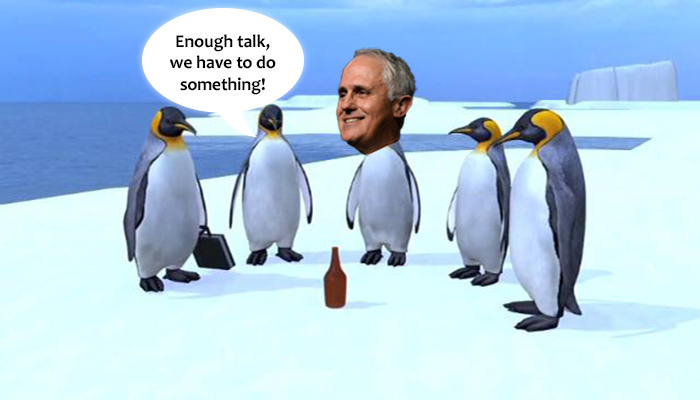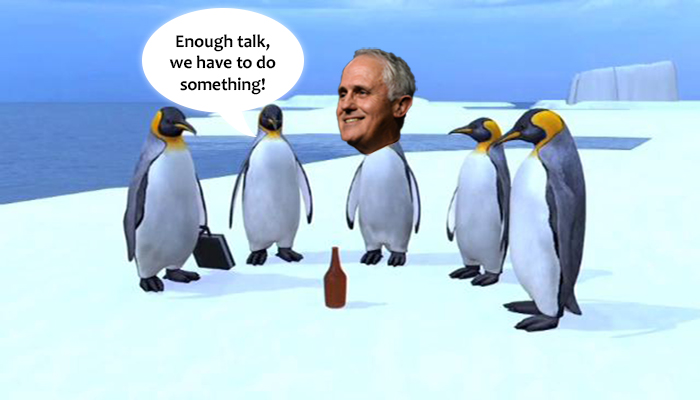We watch politicians as one way to learn the do’s and don’ts of communication and change management.
For the second time in his prime ministership we are waiting on Malcolm Turnbull to give us his vision that will define his period as leader.
Paul Keating famously framed Prime Ministership this way (in this interview at 19:30):
“The power of the Big Idea carries with it its own momentum. For instance, the narrative I had when I was treasurer and prime minister was we could no longer go down the cloved pathway, a country ring-fenced by tariffs, with a managed exchange rate, sclerotic financial markets. … These were big ideas and if you market them and tell the story properly, I think you can cut through the static. The static rises when the volume of the ideas are turned down.” 
Last time we wrote about Turnbull’s lack of vision was shortly after he replaced Abbott as PM, but unfortunately the silence remained until the election, and his meandering leadership was reflected in declining support.
That need for the PM to define a direction is, to us and many CEO’s who face daily leadership challenges, an essential. It’s certainly not new, asking a leader to communicate a direction. In fact, many CEO’s believe, like Keating, that there’s a constant need for followers (employees, shareholders, customers) to be engaged in the next ‘Big Idea’.
Some also say the ability to define and execute a vision, a Big Idea, differentiates Leaders from Managers.
MT said on Four Corners this week:
Budget repair will be a front of mind issue for this entire parliament.
The words of a manager or a leader? In this sense we think both Malcolm Turnbull and Hilary Clinton are similarly struggling to excite their peoples. Not only does the absence of a Big Idea inhibit the pace of reform, it leaves a vacuum for unexpected ideas or leaders to take seed: Trump, the Brexit, Hanson.
Compare Turnbull’s commitment to ‘budget repair’ to Theresa May’s statement to the UK, once she became its Prime Minister, defining her vision (and like Turnbull, she’s on the conservative side of politics):
That means fighting against the burning injustice that, if you’re born poor, you will die on average 9 years earlier than others.
If you’re black, you’re treated more harshly by the criminal justice system than if you’re white.
If you’re a white, working-class boy, you’re less likely than anybody else in Britain to go to university.
If you’re at a state school, you’re less likely to reach the top professions than if you’re educated privately.
If you’re a woman, you will earn less than a man.
If you suffer from mental health problems, there’s not enough help to hand.
If you’re young, you’ll find it harder than ever before to own your own home.
But the mission to make Britain a country that works for everyone means more than fighting these injustices. If you’re from an ordinary working class family, life is much harder than many people in Westminster realise. You have a job but you don’t always have job security. You have your own home, but you worry about paying a mortgage. You can just about manage but you worry about the cost of living and getting your kids into a good school.
If you’re one of those families, if you’re just managing, I want to address you directly.
I know you’re working around the clock, I know you’re doing your best, and I know that sometimes life can be a struggle. The government I lead will be driven not by the interests of the privileged few, but by yours.
We will do everything we can to give you more control over your lives. When we take the big calls, we’ll think not of the powerful, but you. When we pass new laws, we’ll listen not to the mighty but to you.
An Era of Rapid Change – an opportunity or a threat
There’s now an added imperative for a leader’s vision. Change is everywhere. All of us are either on top of it, or being subsumed by it. I believe we can currently divide the world, not just into the haves and have-nots, but the people who are surfing the wave of change and those who are complacent; the people getting ahead and the people consequently left behind.
One mentor on this is John Kotter, the Harvard professor who is the guru on change-management. He’s managed to make the complex simple with his 8-step guide.
The first three steps create the climate for change.
- Create a sense of urgency
- Enlist an inner circle
- Define a path – a vision, plus how we’re going to achieve it.
One idea – unexecuted – of the PM’s was to define Australia as an ‘Innovation Nation’. Although the phrase is hackneyed, creating an innovation nation certainly fulfils a need.
Next, Kotter mandates we have to engage the people (employees, shareholders, or in this case the country):
- Get buy-in by communicating the new direction
- Empower a wider group of people to achieve the vision
- Create short term wins.
Then finally is bedding in the change, and preparing for the next:
- Keep the momentum going
- Bed in the change to make it stick.
To people familiar with Change Management principles none of this is rocket science, although most agree the execution is difficult. But no-one can get buy-in without 4.
For those who are interested in reading Kotter’s approach, but have limited time, try one of his short fables “Our Iceberg is Melting” – the story of Fred, one of a colony of complacent Emperor Penguins.






